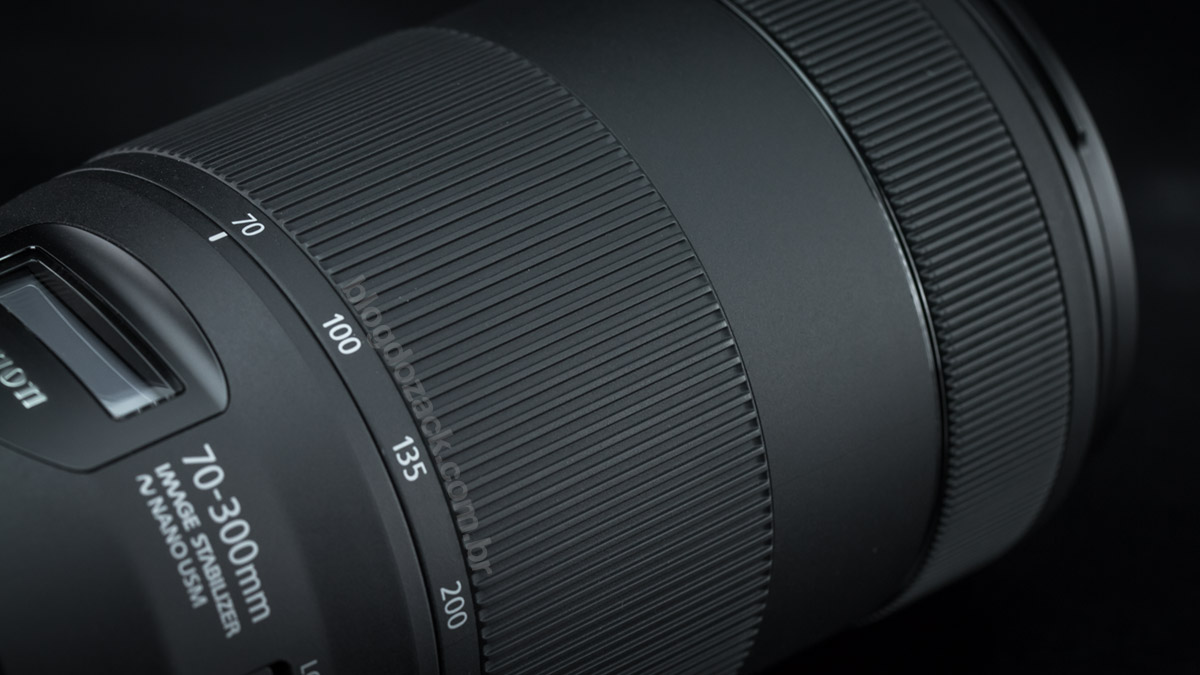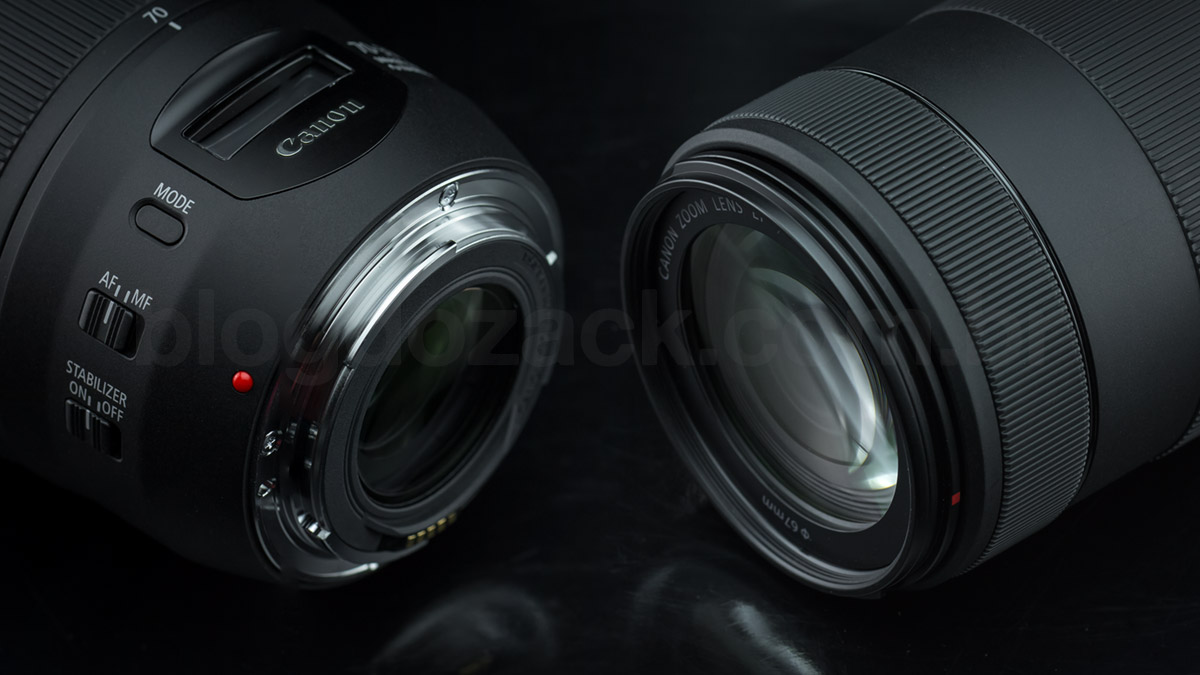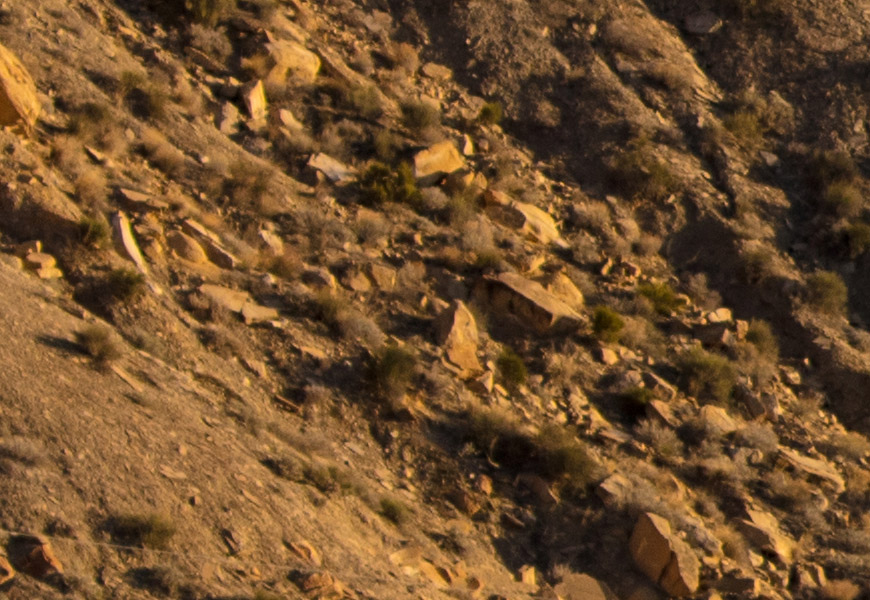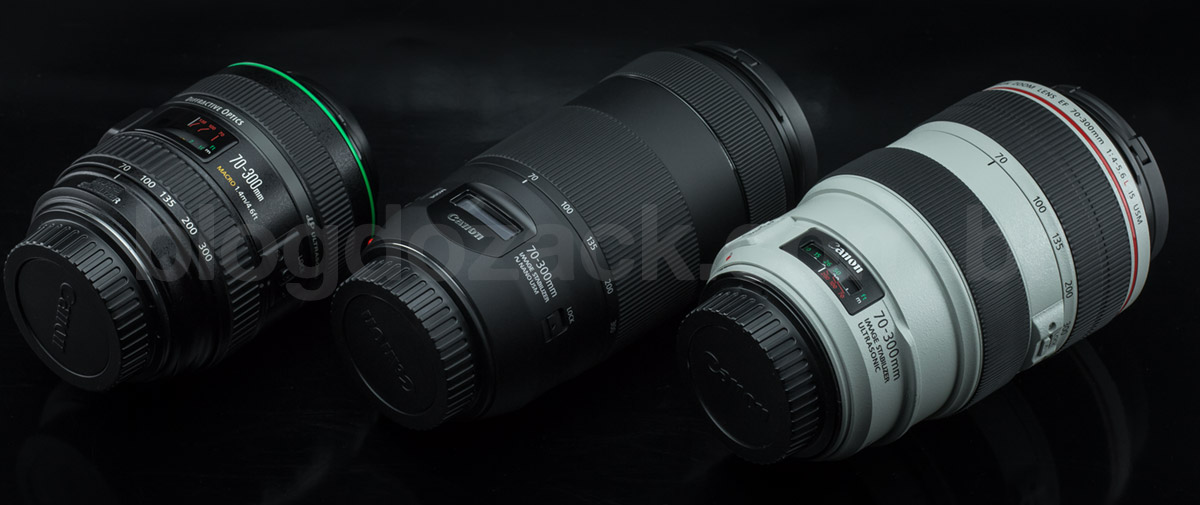Estimated reading time: 12 minutes.
May/2017 – The Canon EF 70-300mm f/4-5.6 IS II USM, launched in September 2016, is the next generation of the exactly same specification launched in 2005. That was already an update to the 1995 75-300 IS, the first EF lens to sport a built-in image stabilizer, Canon is known for its “70-300” lineup, today with three contemporary models: 70-300mm f/4-5.6 L IS USM (top of the line, all metal build, USM AF and two UD elements); 70-300 f/4.5-5.6 DO IS USM (the first zoom Fresnel on the market, smaller than average, recently discontinued); and now the new 70-300mm f/4-5.6 IS II USM, made for the non-professional, consumer market. With an all-new NANO USM AF, an updated 4-stops IS and a new design school, is the 70-300mm IS II USM worth the upgrade? Let’s find out!

At 14.5 x 7.8cm closed at 70mm, or 21.5 x 7.8cm extended at 300mm, all at incredible 710g of plastics, rubbers and glass, the first thing we notice on the new 70-300mm f/4-5.6 IS II USM is how it grew compared to the previous generation. What used to be a skinny barrel at about ø7cm, with pronounced side control switches at the rear, now is a single width tube from end to end, much like the also-telephoto Nikkor AF-S VR 70-300mm f/4.5-5.6G ED; both hard to fit inside smaller backpacks. The new 70-300mm II is big and heavy, a significant leap to those who used to see the consumer version as a portable 70-300mm alternative, now without any options on the EOS family (the 70-300 DO was recently retired on the lineup). Canon sees the telephoto market as something serious, and it’s a practical decision when it’s time to purchase: if you’re looking for a portable lens “too see from afar”, this is not the lens for your EOS camera.

At least what the 70-300mm II has in size and weight, it delivers in usability and ergonomics. While the 70-300mm IS USM offered an average user experience, with “cold” plastics and various tactile feedbacks (different textures and width), the new 70-300 II is much smoother to the touch, better to balance with larger EOS full frame DSLRs. Canon acknowledged it won’t compete with the mirrorless cameras portability, so it’s been betting on ever larger lenses, a pleasure to hold in hands. Your fingers are now treated with a satin plastic, “warm” as the rubber used on Sigma’s Art lenses, but harder to scratch. A new school of design is born on the EF lineup, that doesn’t take ahead the texturized plastic found on the EF 35mm f/2 IS USM, nor uses the high-tech plastic found on the EF 100mm f/2.8 L IS USM. The intermediary lineup now uses a satin plastic, employed on the updated EF-S 18-135mm f/3.5-5.6 IS USM; not as cheap as the STM, nor as expensive as a (L) lens.

In your hands the 70-300 II copies the “beer can” approach from the Canon EF 35mm f/1.4 L II USM. Near the camera mount, the barrel doesn’t rotate, making it easier to attach to the camera. In the barrel center a large zoom ring sports a generous 6.7cm barrel, 3.9cm rubberized for better grip, turning counter-clockwise from 70mm to 300mm at just 90º. The zoom movement is reasonably “heavy” on my brand new copy, in spite of being smooth, without any torque differences between focal lengths; infinitely better than the Zoom-Nikkor AF-S 70-300mm G, that required my shoulder’s weight to turn from one side to the other. Canon thinks the ring mechanism is going to get lighter as the user wear the internal pieces, so it places a LOCK switch at the 70mm position, to avoid zoom creep; something I’ll let a future reviewer to test. At the front the 2.3cm focusing ring doesn’t rotate when the AF motor is operated, a major complaint on the previous micro-USM model. The 70-300 II operation is smooth, a step ahead the intermediary version from a decade ago.

To the left, the physical switches for the IS and AF showcase Canon’s new design school. Instead of a pronounced panel with large switches like the L-series, the 70-300 buttons are built in the plastic barrel, with tiny plastic teeth for grip, both with ON and OFF positions. Above them, for the first time we find a MODE button, that controls one of the 70-300 II novelties: a LCD screen instead of a distance window. Here is how it works: a tiny matrix LCD panel displays 1) focusing distance data; 2) focal length and 3) IS level. On the distance mode, both feet and meter markings are electronic displayed, together with an interactive depth of field scale, that changes depending of the focal length. The focal length mode repeats the numbers printed on the barrel, or can automatically calculate the equivalency to the 35mm format, when mounted on APS-C/APS-H cameras; neat! And the IS mode shows the volume of compensation in both axis, useful to keep the lens steady when shooting low-light scenes. Do notice that’s not an angular value, like the data measured by the camera’s gyroscope. The camera’s battery feed this LCD screen with zero impact in battery life, and it’s necessary to implement this lens main headliner: the new NANO USM AF.

Canon’s NANO USM is nothing more than a linear motor driven by ultrasonic vibrations. Instead of a rotary ring like the “ring-type” USM, thought out for maximum torque to drive large lens elements, the NANO USM uses linear racks just like the Fuji XF 18-135mm f/3.5-5.6 R LM OIS WR. The difference is that NANO USM actually uses vibrations via two energized pins, a simplified and efficient method to generate energy, with the same instant focus offered by ring-type USM; also keeping the STM silence and smoothness for video. And frankly, Canon has a new paradigm in low-cost focusing tech. First, the NANO USM is absolutely silent. If it wasn’t for some slight shift in weight, due to glass elements movement, we wouldn’t be able to tell that the whole thing is working. Second, the NANO USM is also absolutely free of vibrations, with just a slight push/pull felt in hands due to the movement’s inertia. But third and most importantly, the NANO USM is de-facto the fasted AF motor I’ve ever used: making every telephoto obsolete (and we’ve seen some very high-end models).

On a daily usage the EF 70-300mm f/4-5.6 IS II USM have the fastest AF system I’ve ever used in my whole life. Here tested with the top of the line EOS 5DS, is when we see how Canon’s DSLR phase-detection systems paired with novelty AF motors have a large advantage over any technology offered by today’s mirrorless cameras. For example the Fujinon XF 18-135mm f/3.5-5.6 LM R OIS WR: it uses the same principle as NANO’s USM, but no Fuji camera features the hardware to 1) instantly measure the focusing distance and 2) feed so much power to drive the motor as fast (and we’ve seen both top-of-the-line X-Pro2 and X-T2). Canon’s precision is also excellent, with practically 100% focus chance on this review’s photos, including during AF SERVO tests; a breath of fresh air coming from two mirrorless reviews, EOS M5 and A6500, with fewer photos in focus. Although not all is perfect with the NANO USM, again using a laggy fly-by-wire manual focusing ring.

“Helmet” with the EOS 5DS + EF 70-300mm f/4-5.6 IS II USM at f/6.3 1/1000 ISO2500 @ 300mm.

100% crop, all photos in focus using the 5DS AI SERVO.
Also Canon updated the Image Stabilizer (IS) inside. The previous generation was no slouch at up to 3-stops of compensation, almost mandatory to shoot at telephoto distances. But the new version II brings at least 4-stops of compensation, delivered in the most elegant possible way: noiseless, smooth, quiet and instantaneous. In reality I could easily achieve 1/4 shutter speeds at 70mm; almost half a second handheld, not really carrying about my posture. At 300mm, the IS module also shines: 1/160, 1/80, 1/140, 1/20 are easy to shoot, maybe surpassing the 4 stops at 1/10; amazing! Canon also promises auto sensing the tripod or panning movements (mode 2), both great to use during video recordings using the EOS 7D Mark II, EOS 80D, EOS 5D Mark IV and EOS M5 Dual Pixel sensors. The stabilizer works they way it should, on an easy to use telephoto lens.

Finally at the front the filter grew to ø67mm (it was ø58mm), the same size found on the L-series. They attach to a plastic thread, thick and robust, harder to damage under impact. This thread fits inside a secondary lens-hood thread, unfortunately not included in the US$549 package (Canon includes the hood and the pouch only on the L-series). At the rear the metal mount is well built and also robust, although there’re no rubber gaskets to tell a story about weather sealing (neither Canon declares it). Also the last glass element is quite pronounced at the rear, making it impossible to attach any EF Extender (1.4x or 2x); only extension tubes are compatible. The 70-300 II is a sizable upgrade over the previous model, larger, heavier, more robust and equally better to handle. The new NANO USM auto focus is a giant leap forward, flirting with an unexpected Canon future: consumer level EF lenses sporting faster focus speeds than pro-oriented L-series. The main difference stands at its build and optical performance that, as we’ll see, is not perfect.

“Forest” at f/8 1/160 ISO200 @ 147mm. All photos with the Canon EOS 5DS; some raw files available at Patreon.
With a 17 elements in 12 groups formula, two more than the older version and the same, single UD glass, now in a new position, and a new aperture diaphragm sporting 9 rounded blades (it was 8 on the 2005 lens), the 70-300mm II optical performance seems intact over time. The resolution is good at most apertures, but never as clean as the equivalent primes (like the 70-300L was), but ahead of most “low-cost telephoto zooms” in contrast and aberration control. The image quality might be just “fair” to the price, easy to recommend to most photographers, provided they keep their expectations low: here tested with the monster 50MP Canon EOS 5DS, it’s hard to hide its flaws, and the 70-300 II is filled with them. However it’s hard to shoot an “unpublishable” shot, leaving us to a simple conclusion: you get what you paid for, and that’s not for Canon’s best telephoto.

“El Capitan” at f/8 1/80 ISO160 @ 70mm.
That’s not to say the EF 70-300mm f/4-5.6 IS II USM drops the ball in terms of resolution; it has plenty of it. Under perfect situations, it’s easy to render details in trees, rock textures, the skin on portraits, almost at the same level of much more expensive lenses. But the problem stands with this “perfect situations”: the slight shift in focal length or focusing distances, and the image quality is gone, given the aberrations and questionable sharpness. For example landscapes: it’s easy to see colored lateral chromatic aberration lines competing for detail pixels, given the small glass pieces at the edge of the f/4-5.6 spec. Here’s the thing: the similarly specced 70-300mm L features much larger glass elements, guaranteeing better overall image quality. That was an issue on the similarly good EF-S 55-250mm f/4-5.6 IS STM: it was good on the center frame, but lacked overall performance due to the tiny glasses. So there are fever moments of brilliance from these models, and you shouldn’t expect top of the line results from them.

“Bryce Canyon” em 1/1000 f/5.6 ISO100 @ 300mm.

100% crop, fair resolution when used on the 50MP EOS 5DS.

“Mesquite Sand Dunes” at f/5.6 1/160 ISO100 @ 300mm.

100% crop, wide open aperture not enough for maximum resolution.

100% crop, the quality leaves much to be desired, making the optics feel cheap.
Stopping down has no impact on optical performance, once the maximum aperture is already quite small. I didn’t notice any improvement in corner resolution, nor aberration fixing, varying from f/4 to f/8. The only visible gain is the reduced vignetting at f/7.1. So shots taken at evening using the f/5.6 aperture and 300mm focal length look from a peephole, asking for double attention during exposure: remember to stop the aperture down for better clarity. It’s also stopped down that most aberrations are (but completely) gone. Be it backlit or surrounding low contrast lines, it’s easy to see colored lateral chromatic aberration lines that just don’t exist in real life. Although it’s an easy fix in post, and it can even happen in camera (for those shooting JPEGs), it’s another issue I didn’t found as heavily on the 70-300L; thanks to it two UD (ultra-low dispersion) glasses.

100% crop, slight moment of brilliance stopped down.

100% crop, plenty of details for large prints, from a consumer zoom lens.

100% crop, the lateral CA is there, but it’s kind of discreet.

100% crop, discreet lateral CA even at 50MP.
On a positive note is the practically non-existent geometric distortion, at least at normal working distances, outside of the minimum 1.2m. It’s specially useful for landscapes, not messing the horizon lines at all focal lengths, one less box to tick in during post processing. On the other hand product photography do reveal a slight barrel distortion at 70mm, and some pincushion at 300mm, standard zoom behavior near the minimum focusing distance. But it’s less than even the more expensive 70-300L, that showcased greater distortion at infinity. It’s interesting to see how the flaring is well handled on the new lens, thanks to Canon’s coatings. Photos including the light source, like the sun during the golden hour, are clear and free from colored blobs, also keeping the contrast strong; great for those using the effect in portraits.

“Road” at f/7.1 1/400 ISO100 @ 300mm; no signs of geometric distortion.

“Yosemite” at f/5.6 1/1000 ISO100 @ 118mm; well controlled flares.

“Yosemite II” at f/7.1 1/100 ISO100 @ 91mm; high quality coatings avoid light leaks and reflections.
Finally the colors and bokeh are the last highlight of the new design, always a happy story on Canon’s telephotos. The straight-out-of-camera saturation is quite muted, but tones are very neutral; the idea is to post-process at will prior to publishing. The RGB spectrum is well defined with “dense” shadows and highlights, in line with Digital EOS’s color science, pushed to an more orange-ish hue. However the background out of focus quality is smoother than ever, thanks to the newer circular 9-blade aperture. Even at f/8-f/11 the depth of field is quite short at 300mm, so the circular aperture makes a positive difference. The “bokeh balls” (blurred highlights) are smooth and pretty, superior to the “rolled condoms” found on 70-300DO, given that lens Fresnel design. So this 70-300 II is nice to photograph smaller subjects like flowers and close-ups.

“Skate II” at f/5.6 1/1600 ISO500 @ 187mm; a faraway subject, highlighted in front of a blurred background.
The EF 70-300mm f/4-5.6 IS II USM far surpasses the “natural upgrade” designation, as Canon updated nearle everything on its usability, design, build, AF, IS… It’s a completely revamped product, filled with never-seen-before ideas on the EF lineup. The build quality is nice for the price, cheaper than the lens it substitutes (at least at launch, the 2005 70-300 IS USM was US$649, US$149 more than the II US$499), in spite of Canon’s newest design school. The satin plastic is smooth to the touch, without the hassle of Sigma’s Global Vision rubbers, and as durable as the L series metals. The smooth operation is a leap forward the previous generation, with a sizable barrel to balance well on full frame cameras, raising the bar on its ergonomics. The novelty LCD screen in welcomed and allows a traditional function to work with the newest AF tech, that is rooted on Canon’s legacy. It’s absolutely instantaneous, quiet and cheap, giving consumers the same focusing speeds that professionals get on top telephotos. It will be interesting to see how Canon will actually position the NANO USM together with a ring-type USM, and which lens will get which AF. And the Image Stabilizer is as useful as ever, also leading the market in performance.

But the image quality is barely acceptable, not really delivering what the “high density” market needs; and that’s the 5DS with its 50MP. While most photos showcase great contrast, color tones and aberration control, frankly the EF 70-300mm f/4-5.6 IS II USM was the worst lens tested so far on my 5DS, that says a lot about 1) the intermediary lineup and 2) Canon’s inability to push the limits in optical design/ price ratio (like Sigma does on its Art series). The new lens is a leap forward the previous generation, but only if the camera resolution stands still in time; and that’s a problem. It will serve Canons full frame 24MP EOS, with plenty of resolution, similar to most primes. But it won’t work on never 30+MP bodies, better served by the 70-300 L-series. For the rest of the market, the 70-300 II is a new paradigm in ergonomics and focusing performance, never seen before from Canon. It’s a pleasure to use, so nice shooting!